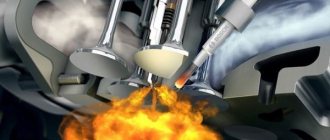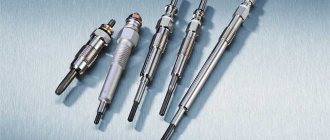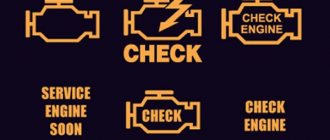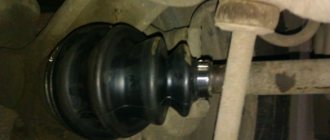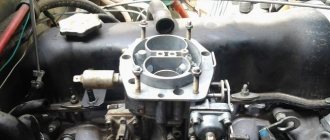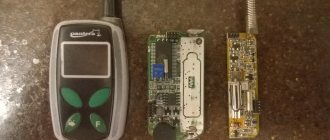The task of glow plugs is to heat the air in the combustion chamber of a diesel car as quickly as possible, since ignition of the mixture, in this case, occurs at a temperature of 800–850 C and this indicator cannot be achieved by compression alone. Therefore, after starting the engine, the spark plugs must work until its temperature reaches 75°C .
In relatively warm weather, the failure of one or two glow plugs may be unnoticeable, but with the onset of cold weather, difficulties immediately arise in starting a diesel engine and the need to check the spark plugs.
The duration of the current supply to the spark plug and the voltage level are controlled by a relay or a special electronic unit (candles, when heated to 1300 degrees for 2–30 seconds, consume a current of 8 to 40A each). On the dashboard, a spiral-shaped light shows the driver that it is too early to turn the starter until it goes out. In modern designs, electronics monitor the engine temperature, and if the engine is warm enough, it does not turn on the spark plugs at all.
A glow plug can fail for two reasons:
- the life of the spiral has been exhausted (approximately after 75–100 thousand km);
- fuel equipment is faulty.
Signs of faulty glow plugs
Indirect signs of the presence of a malfunction:
- When starting, white-gray smoke comes . This indicates that fuel is flowing but is not igniting.
- Rough operation of a cold engine at idle . The noisy and harsh operation of the engine can be noticed by the shaking plastic parts of the interior due to the fact that the mixture in one cylinder ignites late due to the lack of heating.
- Difficulty starting a diesel engine when cold . You have to do several repetitions of spinning the engine with the starter.
Clear signs of a bad glow plug will be:
- Partial destruction of the tip .
- A thick layer of carbon deposits on the tip near the body.
- Swelling of the glow tube (occurs due to excess voltage).
How can you check the glow plugs of a diesel engine?
How to check?
Depending on the model and age of the car, there are different principles of operation of the diesel engine heating system:
- In older cars, glow plugs usually turn on almost every time the engine is started.
- Modern cars can start successfully even without glow plugs at above-zero temperatures.
Therefore, before starting to diagnose the diesel preheating system, you need to find out at what temperature conditions the combustion chamber is heated. And also, what type of candle, since they are divided into two groups: rod (the heating element is made of a refractory metal spiral) and ceramic (the heater is ceramic powder).
Environmental standards Euro 5 and Euro 6 provide for the operation of diesel engines with ceramic spark plugs, since they have the function of pre-starting and after starting heating, which allows the fuel to be burned in a cold engine, as well as an intermediate glow mode necessary to ensure regeneration of the particulate filter.
To check the spark plugs of a Ford, Volkswagen, Mercedes or other car diesel engine, you can use several methods , and depending on whether they are unscrewed or on the engine, the principle will be the same. Functionality testing can be done using:
3 ways to check glow plugs - video
- Battery _ On the speed and quality of incandescence;
- Tester . By checking the break of the heating winding or its resistance;
- Light bulbs (12V). The simplest test for breakage of the heating element;
- Sparking (can only be used in old diesel engines, since new ones are dangerous due to ECU failure);
- Visual inspection.
The simplest diagnosis of glow plugs is to check their electrical conductivity. The spiral must conduct current, its resistance in a cold state is in the range of 0.6–4.0 Ohm . If you have access to the candles, you can “ring” them yourself: not every household tester is able to measure such a low resistance, but any device will show the presence of a heater break (the resistance is infinity).
If you have a non-contact (induction) ammeter, you can do without removing the spark plug from the engine. But it is often necessary to inspect the working part, on which signs of overheating may be noticeable - melting, deformation of the tip, up to its destruction.
In some cases, in particular if all spark plugs fail at once, it may be necessary to check the vehicle's electrical equipment. Namely, the spark plug control relay and its circuits.
We will describe all the ways to check diesel glow plugs. The choice of each of them depends on skills, availability of equipment, tools and free time. But ideally, you need to apply everything together, plus a visual inspection.
Tips for choosing a part
The glow plug relay is a part that, if it fails, makes it impossible to start the engine in cool or frosty weather. Therefore, if the device burns out, it must be replaced with a new one. When purchasing a relay, you must adhere to the recommendations below.
View gallery
What should you pay attention to when choosing a glow plug relay? So:
- Country of origin and company.
Before purchasing a new spare part, you must find out what brand the burnt part was. This will help you purchase an original part or a high-quality analogue. It is worth noting that you should not try to install relays from other models. Each device functions in connection with the design features of the car brand for which it was created. If you install, for example, a relay from a Gazelle on a Ford, then in the best case it will burn out quite quickly. And at worst, it will lead to malfunctions associated with the electrical supply of the entire unit.
- Relay type.
Relays have many typologies. One of the main criteria for separation is the area of their application for steel or ceramic glow plugs. When purchasing a new glow plug relay, you need to pay special attention to this. If you purchase a part designed for steel spark plugs when ceramic spark plugs are used in the car, then such a relay, accordingly, will not function. The same thing will happen if you put a spare part for ceramic spark plugs on a model with steel ones.
- Cost of the mechanism.
The price of original spare parts and high-quality analogues is quite high. However, it should be understood that in return the motorist receives a fairly reliable relay that will not fail in a difficult road situation. Using low-quality cheap Chinese counterfeits will lead to a loss of time, and this is at best. In the worst case, the car may stall while driving, and this, accordingly, will lead to a dangerous situation on the road. Also, a low-quality relay can cause more serious damage to the car.
View gallery
How to check glow plugs without unscrewing them (on an engine)
Checking glow plugs should begin by finding out whether voltage is supplied to them at all, since sometimes the contact of the supply wire simply oxidizes or weakens. Therefore, there is no way to check without a tester (with ohmmeter and voltmeter modes) or, in extreme cases a 12 volt light bulb .
On an engine, glow plugs can only for their general performance , since the intensity and speed of heating of the heating element cannot be seen (only on some engines you can unscrew the injectors and look through their wells). Therefore, the most reliable diagnostic option would be to unscrew the spark plugs, check the battery and measure the indicators with a multimeter, but for a quick check, at least something will do.
Is it possible to check without removing it?
You should immediately see whether current is supplied at all - after all, the contact may oxidize or weaken, which will lead to an open circuit. Here, of course, you will need a tester. Without removing, you can only check the general condition of the spark plugs. In this way it is impossible to determine the intensity of the heating element.
Diagnosing spark plugs is not too difficult. This work can be done in several ways, the most reliable way is to check with a battery. The “old-fashioned way” of checking for a spark is more dangerous than others - if you act carelessly, you can burn the car’s computer.
How to check a glow plug with a light bulb
The principle of checking a glow plug with a light bulb
And so, the first way to check the glow plug on the engine (or already unscrewed) is to use a tester . Two wires are soldered to the 21 W lamp (a light bulb of size or stops will do), and with one of them we touch the terminal terminals of the spark plugs (having previously disconnected the supply wire), and with the second to the positive terminal of the battery. If the light comes on, it means there is no break in the heating element. And so on for each candle in turn. When the light bulb glows dimly or does not light at all , the candle is bad . Since the method of checking a glow plug with a light bulb is not always available, and its results are relative, the next step is checking with a tester.
Checking the spark plug
Checking the glow plug for a spark is similar to the previous method, only it is done without a light bulb and by intensively touching the threaded part.
To check for spark you will need:
- A meter-long piece of wire, stripped of insulation at the ends.
- Disconnect the spark plugs from the power supply bus.
- Screw one end of the wire to the “+” of the battery, and apply the other, with tangential movements, to the central electrode.
- A strong spark will be observed on a serviceable spark plug, but a poorly heated spark will not form.
Location of the part on the Opel car
The part responsible for starting the engine in cold weather on Opel cars is located under the battery platform on the left side. In order to repair or replace the glow plug relay on an Opel, it is necessary to dismantle the fuel filter, the safety block and the battery platform itself. If access remains difficult, you will have to remove the bumper and left headlight.
When replacing a burnt-out glow relay, you should install an original part or a high-quality analogue. Cheap fakes will not last long and reliably. Their use will sooner or later lead to failure to start the diesel engine in cold frosty weather.
How to check glow plugs with a multimeter
Checking diesel spark plugs with a multitester can be carried out in three modes:
Checking the glow plug with a multimeter for a broken spiral
- in dialing mode;
- measure resistance;
- find out the current consumption.
check for a broken heating element without even unscrewing the spark plug from the engine, but to use the other two methods of checking glow plugs with a tester, it is advisable to have them in front of you.
And so, for dialing mode you need:
- Move the regulator to the appropriate position.
- Disconnect the current supply wire from the central electrode.
- The positive probe of the multimeter is on the electrode, and touch the negative probe to the engine block.
- There is no sound signal or the arrow does not deviate (if the tester is analog) - a break.
Measuring glow plug resistance with a tester
This method will only help to identify a completely non-working glow plug, but you will not be able to identify problems with the heating element.
much better to check the resistance with a tester , but for this you need to know the nominal value that a specific spark plug must correspond to. A working spark plug spiral resistance of 0.7-1.8 ohms . Since quite often the spark plugs, although they still fire, already have a high resistance, as a result of which they consume less current and the control unit, having received the corresponding signal, thinks that they have already warmed up and turns them off.
With a high degree of reliability, the result regarding the suitability of the spark plug, and without unscrewing it from the diesel engine, can be found by checking the current consumption .
To measure, you need to: on a cold engine, disconnect the supply wire from the spark plug and connect one terminal of the ammeter to it (or the plus on the battery), and the second to the central terminal of the spark plug. Turn on the ignition and look at the current consumption indicators. The current consumption of a working glow plug, depending on the type, should be 5-18A . By the way, note that in the first second of the test the readings will be maximum, and then, after about 3-4 seconds, they will gradually begin to fall until the current stabilizes. The arrow or numbers on the tester should decrease evenly, without jerking. All tested spark plugs from the engine must have the same current flow values. If something is different on some spark plug or nothing happens at all, then it makes sense to unscrew the spark plug and check the glow visually. When the spark plug is partially heated (for example, the very tip or the middle), the readings will differ significantly, and when there is a break, there is no current at all.
In this case, as when measuring resistance, it is desirable to know the nominal value of current consumption.
When there is no time to make a test light or tools for removing spark plugs, or they are already lying on the table, checking with a multimeter may be useful. But it also has its drawbacks - this method, like checking with a light bulb, does not allow you to identify a candle with a weak glow. The tester will show that there is no breakdown, and the spark plug will not warm up the combustion chamber sufficiently. Therefore, to determine the speed, degree and correctness of heating, as well as in the absence of instruments at hand, it is imperative to check the spark plugs for heating with a battery.
Checking glow plugs using a battery
The most accurate and clear picture of the serviceability of the heating elements is given by checking the battery. Each candle is checked separately, and the degree and correctness of its glow is visible.
The principle of checking the glow plug with a battery
To check, you just need nothing - literally a piece of insulated wire and a working battery:
- We press the central electrode of the spark plug to the positive terminal.
- We connect the negative wire to the body of the heating element.
- Quick heating until red hot (and it should heat up from the tip) indicates serviceability.
- Slow glow or no glow at all – the spark plug is faulty .
For a more accurate test, it would be a good idea to measure the speed at which the tip of the candle heats up to cherry red. Then compare the heating time of each candle relative to the others.
Those candles that heat up earlier or later than the main group (the average time for modern candles is 2-5 seconds) are put aside for scrap. You may ask why throw away those that used to be, because it’s good? When the candles are of the same brand and the same type, heating ahead of time indicates that not the entire element is heated, but only a small part of it. At the same time, very often cracks in the body are observed in these places. So when testing for heating, it is advisable to know the characteristics of the spark plugs or take the values of a new one as a standard.
When the spark plugs, although they work, are heated to different temperatures and at different speeds, then, as a result, the engine jerks (one is already igniting the fuel mixture, and the other is just burning after). Quite often, they can check all the spark plugs at once, connecting them not in series, as it would seem, but in parallel, then everyone will receive the same current strength.
The only difficulty with this method is that you will have to unscrew all the spark plugs, and this sometimes turns out to be quite difficult and time-consuming. But the plus is that in addition to checking for heating of the glow plugs, we also check for hidden defects.
Visual check of glow plugs
A visual check allows you to identify not only defects, but also the operation of the fuel system, the operation of the electronic control, the condition of the piston, so always carefully inspect the glow plugs since they have already been removed.
There are defects on the spark plug
If the spark plugs have not yet reached the end of their service life, but already have signs of overheating (approximately in the middle of the heated rod), the body swells and cracks spread along the sides, then this is:
- Voltage too high. You need to measure the voltage in the on-board network with a multimeter.
- The glow plug relay does not turn off for a long time. Record the response time by clicks or check the relay with an ohmmeter.
Melting the tip of the candle
This may happen due to:
- Early injection of the fuel mixture.
- The nozzles are dirty, resulting in incorrect spraying. You can check the injection torch on a special stand.
- Weak compression and late ignition, which means overheating.
- The pressure valve has closed. Then the engine will work quite hard, and if you loosen (with the engine running) the nut of the fuel line leading to the injector, then not fuel, but foam will come out from under it.
When visually checking the thinnest part of the spark plug (the one that is located in the prechamber), make sure that it is darkened, but not with a melted iron body, and without cracks. Because even if it still works, it will not last long, and soon it will have to be checked again.
How to check the glow plug relay
Glow plug relay
The diesel glow plug relay is a device capable of activating the spark plugs before starting the engine to warm up the pre-chamber, the activation of which, after turning the key in the ignition switch, is accompanied by a clearly audible click. It itself is not capable of deciding the activation period; this function falls on the ECU, which sends a signal according to the readings of the coolant sensor and the crankshaft sensor. Commands from the block allow you to close and open a circuit.
checking the glow plug relay on a diesel engine if there are no characteristic clicks . But if the spiral light on the panel stops lighting up, then first inspect the fuses, and then check the temperature sensor.
Each relay has several pairs of contacts (single-component 4, and two-component 8), since there are 2 contacts of the coil winding and 2 more control ones. When a signal is given, the control contacts must close. Unfortunately, there is no universal designation of contacts on relays of different cars; for each relay they can be different. Therefore, we will describe the verification example in general terms. On many diesel cars in the relay, the winding contacts are designated by numbers 85 and 86, and the control ones - 87, 30. So, when voltage is applied to the winding contacts, contacts 87 and 30 should close. And to check this, you need to connect a light bulb to contacts 86 and 87 and apply voltage to the spark plug relay. The light will light up, which means the relay is working properly; if not, the coil is most likely burned out. The serviceability of the glow plug relay , as well as the spark plugs themselves, can be checked using a tester by measuring the resistance (I won’t say specific indicators, because they vary greatly depending on the model), and if the ohmmeter is silent, then the coil is definitely out of order.
I hope this information will help you in solving your problem, and you can easily figure out how to check the glow plugs of your diesel engine yourself, rather than contacting a service center. After all, as you can see, the test can be carried out not only with the help of a tester, but also with an ordinary car light bulb and battery, literally in a matter of minutes, right in the engine, without unscrewing them from the block.
Glow plugs on diesel engines are often the weak link in cold weather. Owners of such cars often have to cancel planned trips because their engine stubbornly refuses to start. In this article we will describe three simple ways to check diesel glow plugs.
Glow plugs play an important role in starting a diesel engine in cold weather. Thanks to their heating of the combustion chambers, it is possible to facilitate the ignition of fuel in the engine cylinders.
The fastest way to check glow plugs for a diesel engine is shown in detail in the video at the end of the article.
Depending on the model and age of the car, there are different principles of operation of the diesel engine heating system:
- In older cars, glow plugs usually turn on almost every time the engine is started.
- Modern cars can start successfully even without glow plugs at above-zero temperatures.
Therefore, before starting to diagnose the diesel preheating system, you need to find out at what temperature conditions the combustion chamber is heated. The switching on of the glow plugs on the instrument panel is indicated by a corresponding light bulb in the form of a spiral.
Location in a Ford Transit car
The glow plug relay in the Ford Transit is located in the engine compartment. To be more precise, in the front safety block. Its connector is similar to the one installed on the domestic Gazelle, so if necessary, a spare part from a domestic car will do. For long-term driving, when replacing the glow plug relay, you need an original spare part.
View gallery
Many car owners complain about the quality of insulation of their original wires. In theory, they can be replaced, for example, with Chinese or Turkish ones. But the main thing is not to disrupt their connection diagram. Otherwise, the engine will become or stop functioning altogether in the winter season.
Methods for checking glow plugs for diesel engines
The failure of one or two glow plugs may not be noticeable in relatively warm weather. And when frost sets in, difficulties immediately arise in starting the diesel engine.
We will describe three different ways to test the performance of glow plugs. The choice of each of them depends on whether the motorist has certain devices, tools, skills and free time.
Method 1 - Checking glow plugs using a battery
The most accurate and clear picture of the serviceability of heating elements for a diesel engine is given by checking the battery. Each spark plug is checked separately, and the car enthusiast sees the degree of its glow.
The disadvantage of this diagnostic method is the need to unscrew all the glow plugs. This will require a significant amount of time in some cars, as well as the dismantling of some parts that make access to the heating elements difficult.
- To carry out the tests, you will need an insulated wire about 0.5 m long.
- The glow plug is turned upside down by the heating element and installed with the central electrode on the positive terminal of the battery.
- Using an electric wire, you need to connect the negative terminal of the battery and the spark plug body (in the side part).
- If the heating element quickly heats up by more than half, then the spark plug is working.
- If there is no glow or only the tip of the element is heated, the spark plug needs to be replaced.
Below are easier ways to check glow plugs.
Method 2 - Checking the glow plugs with a multimeter
Sometimes there is no time or tools to remove the glow plugs from the head of a diesel engine. In this case, checking with a multimeter may be useful. The device is installed in the position for testing resistance (ohmmeter).
But first you need to disconnect the wire from the glow plugs that supplies current to the central electrode. Each heating element can be supplied with a separate wire, or all candles can be connected by a copper or brass busbar. Now all that remains is to connect the positive probe of the multimeter to the central electrode of the spark plug, and touch the negative probe to the side surface of the housing. If the arrow does not deviate or there is no reading on the digital display, then there is a breakdown in the heating element. The glow plug needs to be replaced.
Tips for removing spark plugs
Observe the following rules for removing parts:
- Warm up the engine before removing the MAZ glow plugs;
- Remove the spark plug with care;
- Carefully remove dirt and deposits using compressed air;
- Just unscrew the old spark plugs;
- Using a reamer in the spark plug connection hole, remove dirt;
- Screw in the MAZ spark plug only by hand;
- Watch the tightening torque.
Don't skimp on old MAZ glow plugs. In our catalog you can buy a good part from 500 rubles with a quality guarantee.
Our consultants can help you choose the optimal MAZ glow plug.
Quick check of glow plugs on a diesel engine
In a Diesel cycle engine, the fuel spontaneously ignites due to the high temperature of the compressed air. When the engine is not warmed up, during the compression stroke, part of the heat is spent on heating the piston, cylinder walls and combustion chamber. To reduce the load on the starter and facilitate cold starting, diesel engines are equipped with a pre-heating system. If, when the temperature drops below +5°C, the engine starts harder, you should check the glow plugs.
Types of control of the preheating system
System with manual spark plug activation.
The heating elements are connected in parallel. Power is supplied to the common positive terminal through a power relay. One terminal of the control coil is connected to ground, and the second is routed into the interior to the switch. By turning on the button, the driver bridges the contacts. The magnetic field created by the coil attracts the bridging contact, closing the circuit of the glow plugs. A similar system has not been used on cars for a long time, since the driver can forget about the spark plugs being turned on, or keep them insufficiently powered or for too long. But this type of power supply is still found in cars today where the standard pre-heating system has failed. Not wanting to bother with diagnostics, checking the relay or replacing the control unit, craftsmen connect the spark plugs through a regular relay and a button in the cabin.
In the late 80s and early 90s, the button in standard preheating systems was removed in favor of a smart relay. A small electronic control circuit allowed the relay to automatically control the activation and duration of operation of the glow plugs. The circuit carries out calculations based on the readings of the coolant temperature sensor. During the preheating phase, a light with a spiral lights up on the dashboard. The control light itself plays the role of a kind of timer. Its attenuation tells the driver that the engine can be started. At the same time, at the moment the crankshaft is cranked by the starter, as well as after starting, the spark plugs themselves can continue to work (the lamp will no longer light up). The post-heating function serves for better combustion of the mixture in a cold engine, which reduces noise, vibration, fuel consumption, and also speeds up warm-up.
Pre-heating system controlled by ECU
. Since all the hardware is now located in the control unit, the electronic relay is replaced by a conventional one. The signal from the engine temperature sensor goes to the ECU, which in turn energizes the control terminals of the coil in the relay. On many modern cars, the hardware responsible for switching on, glow intensity and operating time is located in a separate unit. The glow plug control unit also performs self-diagnosis of the system.
How does the connection type affect diagnostics?
- General connection type (shown above in the control diagrams). The spark plugs are connected in parallel with thick wires or a copper plate. The disadvantage of this connection method is the general power supply and the high current that passes through the relay. Over time, the power contacts of the relay burn out, causing parasitic resistance and reducing the current in the circuit. Accordingly, the glow plugs will not heat up at full strength or will not turn on at all. Cars with this type of connection do not have a self-diagnosis function.
- Group connection type. With this scheme, one relay is responsible for several glow plugs. Thus, the total current in the circuit dropped, which reduced the load on the wires and relays. The main drawback is the lack of a sane self-diagnosis function that would allow identifying a burnt-out spark plug.
- Individual connection diagram. The glow plugs are controlled by a separate unit. Instead of a relay, a power transistor is provided in the block for each heating element. The inclusion of a current shunt (low resistance resistor) in the circuit of each spark plug made it possible to implement the self-diagnosis function. The spark plug control unit monitors the current for each of the heaters. If there are oxides in the circuit, a broken wire or a burnt-out spark plug, the microprocessor records the voltage drop. The fact of detection of a breakdown is recorded in non-volatile memory in the form of a fault code. At the same time, the glow plug warning light will blink on the instrument panel or the Check Engine will light up. Therefore, it is recommended to start checking a modern preheating system with computer diagnostics.
Diagnostic methods
You will do a test to check the electrical circuits of the brake lights and reverse lights. It is difficult to notice the increased resistance with conventional testing, but you can find a break. Remove the connector from the glow plugs. Connect one contact of the control to the positive of the battery, and touch the second contact to the central terminal of the spark plug. If the lamp does not light, there is a break in the heating element inside the candle. A dim glow from the filament indicates high resistance, so the spark plug should also be replaced.
The verification method described above is quite accurate, but still does not allow us to assess the nature of the heating. The candle should be hot from tip to base. Only the tip of the spark plug looks into the prechamber or combustion chamber, and it is the heat from it that produces the most beneficial effect. Therefore, the best test is to remove the spark plug and connect it directly from the battery.
It is not recommended to test self-regulating and ceramic candles using the described method. The heating element will melt if 12 V is applied to it for more than 2 s.
If the heating elements are in order, use a tester and a multimeter to check for the presence of “+” and “–” and test the wires for breaks. Above we studied all possible elements and connection diagrams. All you have to do is study the electrical circuit of the preheating system, and then check all the elements one by one.

